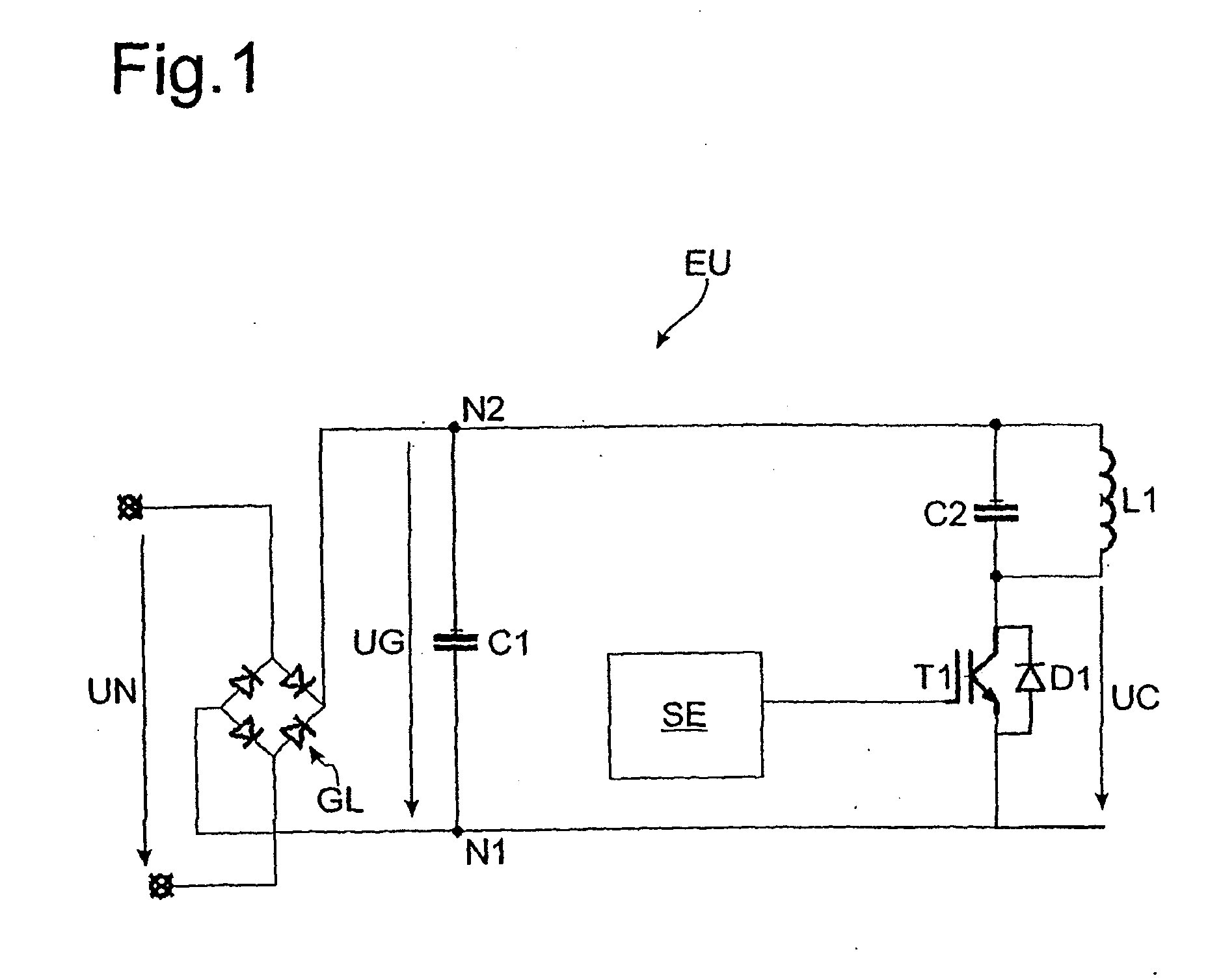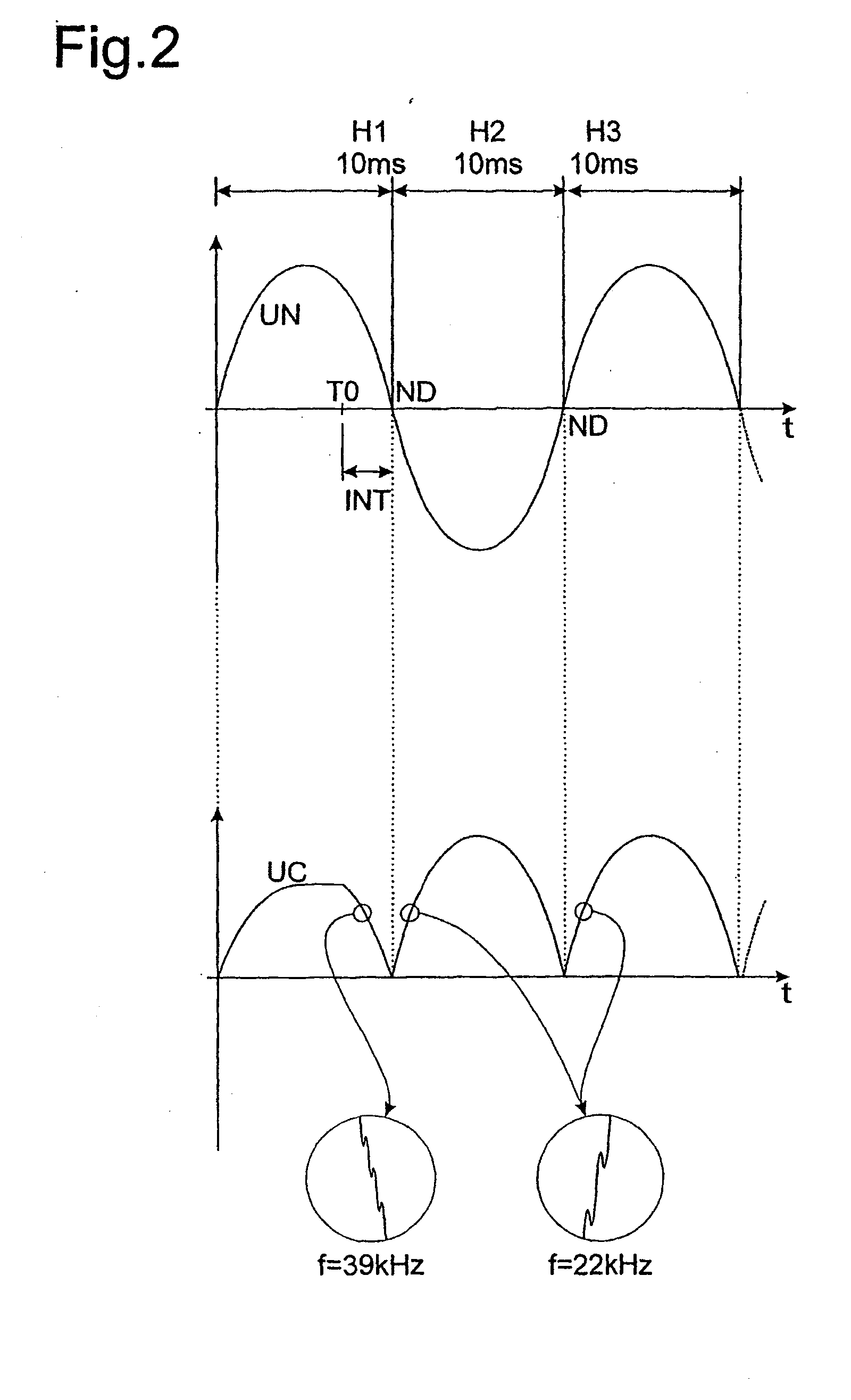[0015]According to one embodiment of the invention, in a time interval prior to a zero passage of the alternating supply voltage, the intermediate circuit
capacitor is discharged down to a threshold value through controlling a switching element, before the induction coil is controlled or activated, for generating an adjustable
heating power or capacity, and during the
discharge there is a limited
heating power supplied to the optionally present cooking utensil. In one embodiment, the intermediate circuit capacitor is discharged in a predeterminable
discharge time range prior to the zero passage of the alternating supply voltage. As a result of the intermediate circuit
capacitor discharge, on starting a heating process, i.e. if the induction coil is to supply
heating power to a cooking utensil, the intermediate circuit capacitor is substantially discharged. If at this time the switching element is switched through or becomes conductive, there is either no or only a limited pulse of current through the switching element and the resonant circuit of induction coil and capacitor. As a result there is no start-up
noise and the pulsed current loading of the power components is reduced, so that their service life is increased. Following the discharge of the intermediate circuit capacitor the actual heating process can take place in the normal way, e.g. the switching element or elements can be controlled by a square-wave
signal with an
operating frequency and an associated operating
duty cycle. Consequently the frequency converter is started with low currents or voltages in the zero passage area. With the rise of the half-wave following the zero passage, the converter can regulate to its
operating point corresponding to the set heating power with an
operating frequency and an operating
duty cycle.
[0017]In a further embodiment the
time range 1 to 5 ms, preferably 2.5 ms, begins prior to the zero passage of the alternating supply voltage. This allows a reliable discharge of the intermediate circuit capacitor, in the case of a comparatively limited
power loss generation in the switching element through the discharge process.
[0019]In a further embodiment the at least one switching element is a
transistor, particularly an IGBT. For discharging the intermediate circuit capacitor, the
transistor is preferably controlled during the discharge such that there is a linear
transistor operating state. As in this mode or operating state the transistor does not completely switch through, the intermediate circuit capacitor is slowly discharged along the supply half-wave. The resulting currents through the parallel resonant circuit and the transistor remain comparatively low, so that
noise evolution is avoided or significantly reduced.
[0021]In a further embodiment the adjustable heating power or capacity is generated with the aid of a half-wave pattern, the intermediate circuit capacitor being discharged prior to the activation of a half-wave. When the heating power is generated with the aid of the half-wave pattern, individual half-
waves of the alternating supply voltage are completely extracted or deactivated, i.e. not used for heating power generation. In a so-called ⅓ supply half-wave operation, for example, only one of three successive half-
waves is used or activated for feeding in power into the resonant circuit or induction coil. During the remaining two half-
waves the switching element remains open, i.e. no power is fed into the resonant circuit. In a ⅔ supply half-wave operation two of three successive half-waves are used or activated for feeding power into the resonant circuit or induction coil. During an active half-wave, power adjustment takes place in the usual way. Supply half-wave operation permits a finer resolution of power stages over a considerable power adjustment range. Such a power adjustment is particularly advantageous for single transistor
converters. If in the case of a conventional operating method of the single transistor converter, use is made of a half-wave operation for power adjustment, during an inactive half-wave, i.e. a half-wave during which no power is fed into the resonant circuit, there is a no-load voltage, e.g. 325 V in the case of a 230 V supply voltage, at the intermediate circuit capacitor.
 Login to View More
Login to View More  Login to View More
Login to View More 


